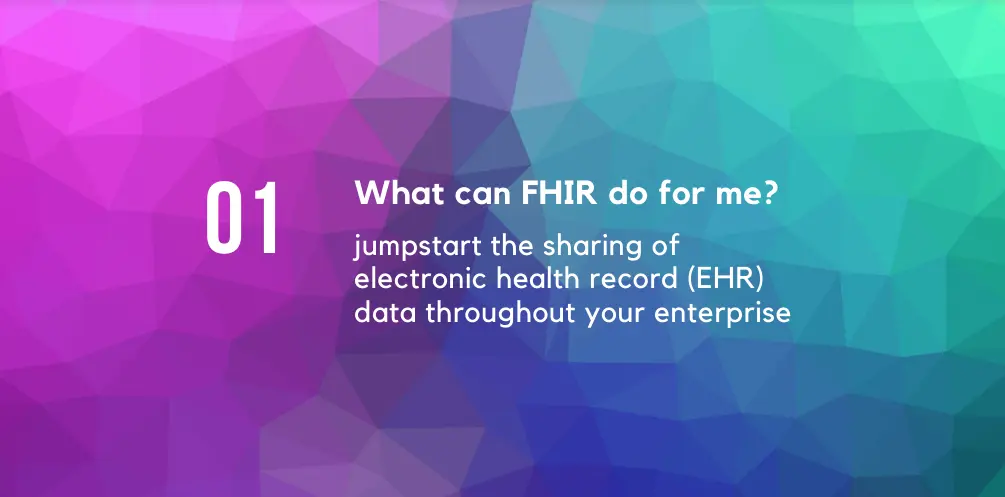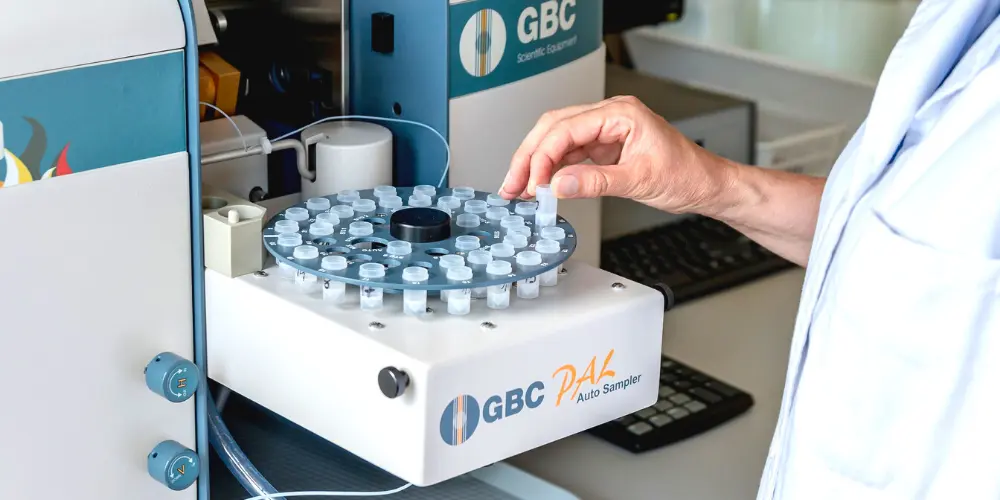What Are The Real-Life Benefits Of FHIR For Healthcare?

Fast Healthcare Interoperability Resources (FHIR) is the standards framework that combines features from Health Level Seven International’s (HL7) earlier product lines with the latest web standards.
FHIR offers many improvements over existing standards. These improvements include increased interoperability in healthcare systems —meaning data can securely flow between mobile phone apps, electronic health records (EHRs), on premise healthcare organizations’ servers and more.
HL7 also cites the following real-life benefits of FHIR for the healthcare industry:
- FHIR is easily implemented
- FHIR has a lower bar to entry for developers
- FHIR is free for use
- FHIR comes with out-of-the-box interoperability
- FHIR is flexible (base resources can be used as-is or adapted as needed)
- FHIR co-exists and leverages the standards that came before it (HL7 Version 2 and CDA)
- FHIR has a strong foundation in Web standards (XML, JSON, HTTP, and OAuth)
- (FHIR has additional benefits can be found here What Are The Real-Life Benefits Of FHIR For Healthcare?)
An ideal healthcare system would use all of the data at its disposal to ensure the resources in the healthcare ecosystem were used appropriately.
The free exchange of healthcare data from one system to another can help deliver the “perfect” healthcare system if we consider four things:
- How the data is shared
- How the data is managed
- How the data is mined
- How the data is integrated
Let’s look at each of these considerations one at a time and examine how FHIR impacts each of them to benefit healthcare.
Benefit 1: FHIR Means Better Data Sharing
How does sharing data generate value in a healthcare setting? Let’s look at three ways.
#1 It Can Empower Patients To Take Ownership Over Their Care
Let’s look at patient empowerment first. We all know that sharing data with patients lets them take more control of their own health and to make better decisions about their own medical care. From diet and exercise to treatment and mitigation, more data means smarter consumers.
#2 It Can Help Payers And Providers Collaborate
The entire industry is moving towards a value-based reimbursement model. This model relies heavily on data sharing between payers and providers. The value is better coordination of care, prevention, and better management of conditions, while at the same time capping costs.
#3 It Can Help Clinical Researchers Provide Effective Treatments
Clinical researchers work on improving treatments. Giving them access to better and more EHR and patient-originated data (as well as other sources such as patient originated data) could be hugely valuable to their research.
What makes FHIR different from previous healthcare data sharing mechanisms is how well it suits implementation with RESTful web services. REST is simple, lightweight and can be implemented with popular and open-source web service technologies—all of which make it easier and cheaper for you to implement them into data sharing.
FHIR gives us 145 individual APIs for sharing data across the entire spectrum of healthcare systems.The FHIR spec is componentized, so you can implement only the APIs required for your specific use cases without the complexity and overhead of the monolithic standards of the past.
Once you have an API implemented, it’s easy to achieve interoperability. You can plug in any API provider or system that conforms to the API specification, which brings flexibility to your architecture. It’s also interesting to note that FHIR is becoming foundational to other standards that increase the value of your data such as SMART on FHIR, which defines how to integrate healthcare applications that utilize FHIR data into EHR systems.
What data sharing concerns will you have to handle yourselves? How will you expose APIs while keeping the data secure? How do you socialize your APIs to ensure they are being used successfully? How do you develop and test your APIs? How do you operationalize and scale your APIs?
Prolifics has been working on the answers to these challenges in developing our Quick FHIR solution.
Benefit 2: FHIR Means Better Data Management
The data that drives the healthcare system comes in many different formats, from a vast number of sources, with varying volumes and frequency. For example:
- EHRs allow us to improve all aspects of patient care, safety effectiveness, timeliness, efficiency and equity.
- Claims data provides additional insights into the treatment and medications that form a patient’s care.
- Vital records inform public health goals and policy.
- Data around prescriptions, imaging, lab work, and all other components of the patient’s healthcare.
- Research is conducted to improve health delivery systems.
- Surveys gather data both to drive research public health policy.
- Wearables deliver immediate healthcare data that provide insight to a patient’s everyday health.
How does FHIR help with the management of all this data?
It provides us with a standard common target data format, transforming information into a usable form. This common format ensures data integrity, accuracy and consistency while clarifying ambiguous meanings and minimizing redundant data. It also makes it easier to consistently apply specific business rules.
Having this data standardized makes it simpler to govern with a data catalog that can track things like who owns it, where it came from, who is allowed to use it, and who has used it and for what purposes.
In spite of these data management benefits, FHIR leaves some homework for you to do. You’ll still need to understand how to ingest the data, how to transform it, how to govern it, and how to address concerns like data privacy.
Benefit 3: FHIR Means Better Data Mining
“Data science” refers to how data is automatically mined for insights. Here’s where the real-life benefits of FHIR for healthcare meet the promise of artificial intelligence and machine learning.
There’s a wealth of extensive value that’s hidden in your data that can be revealed with AI/machine learning . Examples include:
- Training AI/machine learning models to diagnose a condition. Progress is being made on this front, and many studies out there tell us about practitioners that are successfully guided or assisted by AI/machine learning models.
- Training AI/machine learning models to recommend the most effective healthcare procedures or medications that can be used to treat a patient.
- Training AI/machine learning models to reduce the financial burden on the healthcare system by spotting where health resources are being misused, either through inefficiency or fraud.
Those are a few powerful examples of how AI/machine learning can change healthcare for the better.
So what does this have to do with FHIR?
As we saw earlier, FHIR not only provides standards for the APIs and data, but it also tells you how this data fits together in a consistent manner. This standard format is fantastic for machine learning.
Feeding AI/machine learning models bad data will ultimately give you bad outcomes. And if you don’t feed enough data, the insights you get will also be limited.
So what makes for good AI/machine learning models?
- High-quality data. The data needs to have good coverage and represent the entire data space you need to cover.
- Sufficient quantity of data. Machine learning isn’t as effective with megabytes of data as it is with gigabytes or terabytes or beyond. The more data you have, the more reliable its predictions.
- Properly formatted data. The data also needs to be well formed, correctly labeled, with consistent meaning.
FHIR allows you to create sizable, high-quality training data sets sourced from multiple data sources. However, it’s not going to help you with the concerns about how to prepare those data sets, how to actually train your models, how to deploy those models, or how to make the exercise repeatable so your models stay relevant with fresh data. That’s where the Prolifics Quick FHIR Solution closes the gap.
Benefit 4: FHIR Means Better Data Integration

Let’s look at the data integrations that make up your value chain. We’ll consider three examples:
Existing Integration Points
Your value chain may include legacy systems, packages or even new cloud native capabilities that are still in development. In many cases, real-time integrations with systems are required. FHIR can make these integrations more streamlined, with reduced cost and improved efficiencies.
Mandatory Data Exchange Formats
Some of the data exchanges are impacted by regulations that mandate certain types of data exchange formats. HIPAA, for example, mandates usage of X12 standards for electronic transactions.
Distributed Ledgers
Thirdly, let’s consider the promise of blockchain (distributed ledgers) and what it means for integrations between systems or organizations. We’ve moved from a centralized model (where all the data and function was in the mainframe) to a decentralized model (where data and function exist in decentralized systems) and now to distributed ledgers (where everyone has the same data and function and the data is always up-to-date in all locations and for all parties).
This has had profound impacts. First, it means you have instant access to data at the same point as everyone else in the blockchain (with security permissions). This means the data we have is better quality and available without delays. Think about what that means to things like cost transparency! Secondly, it means there’s no need to reconcile different versions of the same data. That can dramatically simplify systems and your value chains. Areas such as claims processing could benefit hugely from this sort of simplification.
How can FHIR help with these data integrations? The standard APIs that FHIR provides can help simplify things. As with the data standard, FHIR APIs provide a common standard target to map your integrations. Whether you’re integrating with non-FHIR systems, having to support mandatory data exchange formats, or whether you’re integrating with the blockchain, these APIs provide standard APIs to build those integrations against, which brings all the benefits of interoperability. Integration points can be reused across multiple systems that have all been integrated to a common API standard.
Again, what FHIR doesn’t tell us how to do is how to connect those integrations, how to transform between formats, how to develop, test, deploy, and scale integrations. Luckily, all of these are addressed by the Prolifics’ Quick FHIR solution.




